During World War II, Filipino guerrillas fought hard against the Japanese in the Philippines. They used smart strategies to slow down the Japanese and win back their land. These guerrilla fighters were key in helping defeat the Japanese.
The Filipino guerrillas weren’t as many or as well-equipped as the Japanese army. But they fought fiercely, using surprise attacks, wrecking enemy plans, and quickly moving away after striking. They also gathered important information silently to support their strikes.
The guerrillas’ success shows the strong will and love for their country among the Filipino people. Their brave actions made a big difference in the war against Japan. Let’s explore how these guerrilla fighters’ tactics shaped the war’s outcome.
Key Takeaways:
- Filipino guerrillas played a crucial role in resisting the Japanese occupation of the Philippines during World War II.
- The guerrillas employed ingenious tactics such as ambushes, sabotage, and hit-and-run attacks.
- The use of intelligence networks allowed the guerrillas to gather vital information.
- Their unwavering resolve and resourcefulness contributed significantly to the eventual liberation of the Philippines.
- The story of the Filipino guerrillas’ WW2 tactics is a testament to the indomitable spirit of the Filipino people.
Introduction to Philippine Guerrilla Warfare
During World War II, the Philippines saw the rise of the Philippine Guerrilla Warfare. This was a resistance movement. It was made up of heroic fighters who aimed to free their land from Japanese control. They used many tactics to weaken the enemy. Let’s dive into the overview of Philippine Guerrilla Warfare, covering its concept, goals, and the challenges they faced.
The resistance was spread out in many small groups all over the islands. This setup made sure they could quickly change their plans if needed. They knew the land well and used this to stop the Japanese. By working in this way, they caused a lot of trouble for the Japanese forces.
“The successful campaign of the Filipino guerrillas was not only a testament to their resourcefulness and bravery, but also an embodiment of the indomitable spirit of the Filipino people.”
The goal of this resistance was to keep the Filipinos wanting to fight until American help arrived. They aimed to make life harder for the Japanese. They also worked to help the Allies with information and other supports. But it was not an easy path to freedom.
The Japanese were very hard to fight against. They had strict rules and would punish not just the fighters but also their families. Yet, the guerrillas did not give up, keeping hope alive and their work going.
The local people played a big part in helping the guerrillas. They gave them food, places to hide, and information. This strong teamwork made it possible for the resistance to continue strong against the Japanese.
As the Allies gained more power, the guerrillas were key in helping them. They shared important information and supported the American soldiers. Their actions were a big help in freeing the Philippines and showed how brave the Filipinos were.
If you are interested in learning more about Philippine Guerrilla Warfare, check out this article. It talks about the day the Philippines won back their freedom on July 4, 1946.
The Strategic Retreat of General MacArthur and its Impact
During World War II, General MacArthur faced off against Japanese forces in the Far East. He had to make a tough call. MacArthur decided to retreat from the Philippines. This move aimed to regroup his forces and later take back the Philippines.
The retreat deeply impacted the Filipino guerrillas and their people. It led to the loss of important places like Bataan and Corregidor to the Japanese. Many Filipino and American soldiers were captured and suffered a lot.
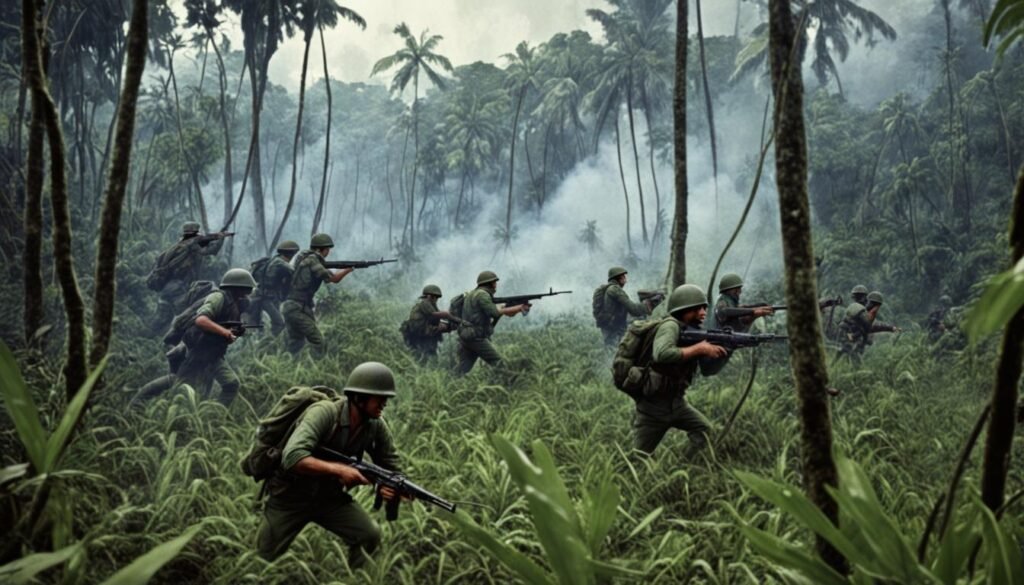
This picture shows the tough choice that General MacArthur had to make. He knew what the results of retreating would be, but saw it as a necessary step.
The Fall of Bataan and Corregidor
When Bataan and Corregidor fell to the Japanese, it was a huge loss. Bataan in Luzon and Corregidor in Manila Bay were vital defense sites. The surrender there marked a significant defeat for the Allies.
Despite the strong fight by the Allies, the Japanese’s force was too much. Bataan gave in on April 9, 1942, and Corregidor followed on May 6, 1942.
After this, the war changed. Japan controlled the Philippines. The Filipinos faced a cruel occupation.
MacArthur’s Promise: “I Shall Return”
General MacArthur’s promise to come back was a big deal. He told the Filipinos, “I shall return.” These words brought hope and courage to those under Japanese rule.
This promise became a symbol of never giving up. It encouraged the Filipino forces against the Japanese. They fought, believing in MacArthur’s return.
MacArthur’s retreat and promise were very powerful. They inspired the Filipino guerrillas to stand strong. This was key in their fight for freedom.
For more on the Philippines’ liberation and MacArthur’s role, visit this link.
The Brave Stand of the Filipino Guerrillas
The Filipino guerrillas showed big bravery against the Japanese in WWII. They fought hard to free the Philippines. Their effort was key in making this happen.
Guerrilla Tactics and their Successes
The guerrillas used many sneaky tactics to fight the Japanese. They hit and ran, set ambushes, and caused damage through sabotage. By attacking important spots, like supply lines, they slowed the Japanese down.
Colonel Wendell Fertig’s Raid on Palawan was a major win. They destroyed lots of enemy stuff and hurt their spirits.
Setting up local spies also helped a lot. The spies passed on important info, making the guerrillas’ attacks precise.
Critical Support from the Local Population
The guerrillas could not have won without the locals. They courageously helped with info, supplies, and by hiding fighters.
The locals acted as the guerrilla’s spies, watching Japanese activities. Their tips were vital for many successes.
They also made sure the fighters had what they needed, like food and medicine. This kept the guerrillas strong.
Filipinos offered their homes for hiding the fighters. This kindness kept the guerrillas safe, making their operations possible.
Working with the local people helped the guerrillas a lot. It was a key part of their victory against the Japanese.
For more info on the liberation of the Philippines, check out this detailed article.
Origins of Resistance: The History of Filipino Defiance
The story of Filipino defiance goes way back, marked by many key moments. Filipinos have always stood strong against those who try to conquer them, even during World War II. Their courage comes from a strong love for their country and a deep history of fighting back.
This fighting spirit began long ago, when the Spanish ruled the Philippines. Heroes like José Rizal and Andrés Bonifacio fought for freedom. The Katipunan, a secret group founded by Bonifacio, was a major player in the fight against the Spanish.
In World War II, when the Japanese invaded, Filipinos didn’t give up. They fought back, showing amazing bravery. Their goal was to win back their freedom and independence.
One memorable battle during this time was the Battle of Manila. It happened from February to March 1945. Filipinos and Americans fought together to free the city from the Japanese. This battle further proved the Filipinos’ dedication to freedom, ready to sacrifice everything.
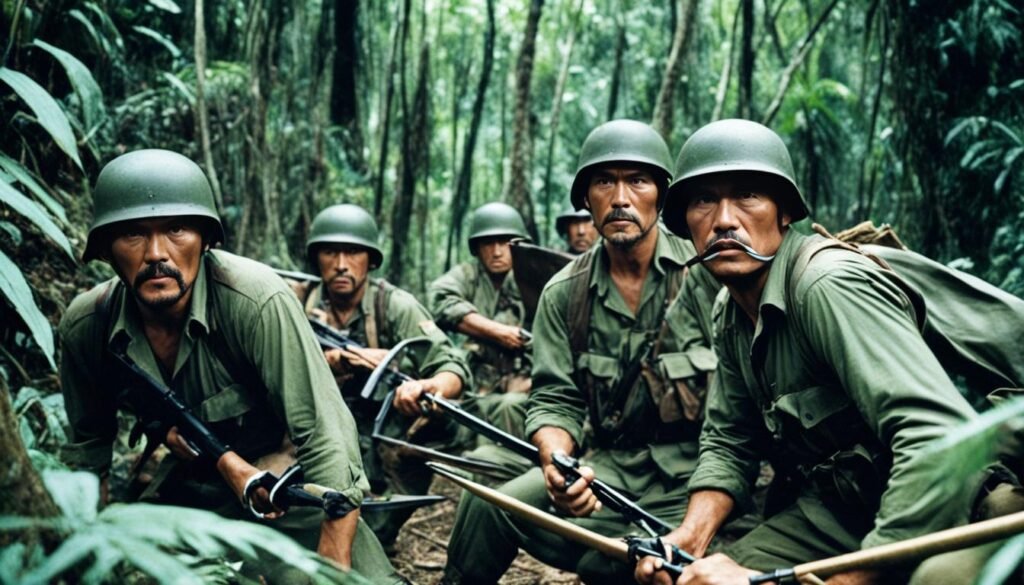
Knowing this history makes us understand and admire their courage. The Filipino people have always resisted invaders, showing great strength in tough times. Their story inspires us all.
Their bravery in World War II is a fine example of their unbreakable spirit. The long fight for freedom prepared them well for this time. Their unity and courage eventually led to liberating their country from foreign hands. It’s a story of true grit and determination.
Learn more about the Battle of Manila and the Filipino defiance during World War II.
Guerrilla Methods and Techniques
The Filipino guerrillas used many ways to fight the Japanese in World War II. Their cleverness and quick thinking helped them do well in hard times.
Advantage of Geographical Knowledge
The guerrillas knew the local land really well. This included deep forests, high mountains, and lots of secret tunnels. Knowing the area so well let them move fast and stay hidden. This gave them a big edge over the Japanese.
Hit-and-Run Tactics
One main strategy for the guerrillas was hit-and-run. They’d attack Japanese soldiers or places quickly, then run back to safety. This way, they caused trouble for the enemy but kept themselves safe.
The Use of Intelligence Networks
Using spies and friends to get news was crucial for the guerrillas. They had lots of people keeping an eye on the Japanese. This info helped them plan carefully and work together well.
| Methods and Techniques | Advantages and Results |
|---|---|
| Geographical Knowledge | Enhanced navigation, concealment, and surprise attacks |
| Hit-and-Run Tactics | Disrupted Japanese operations, minimized casualties |
| Intelligence Networks | Accurate information, efficient coordination of actions |
Notable Guerrilla Units and Their Leaders
During World War II, the Philippines had many guerrilla units fighting against the Japanese. These groups were crucial in the fight for independence. They fought bravely to free their homeland. Here are some key units and their leaders:
The Hunters ROTC Guerrillas was a major force. Led by Colonel Emmanuel V. de Ocampo, they did intel work, sabotaged, and supported the Allies. Their efforts were vital in freeing Manila.
The Hukbalahap, known as the Huks, was important too. Luis Taruc led them. They were focused on Marxist ideals but turned to fight the Japanese in WWII. They were skilled in guerilla tactics.
The Mindanao Guerrillas were under Captain Salvador Abcede’s leadership. They attacked Japanese lines, slowing them down. Their flexibility and cleverness were key in a tough region.
Then, there were the Blackburns Guerrillas, with Lieutenant Colonel Wendell Fertig in charge. They fought in Mindanao, using guerilla methods. Fertig’s smart leadership made them very effective.
These units and leaders were just some of those who stood up to the Japanese in the Philippines. Their stories of bravery and freedom fighting inspired many. Together, they helped win their country’s freedom back.
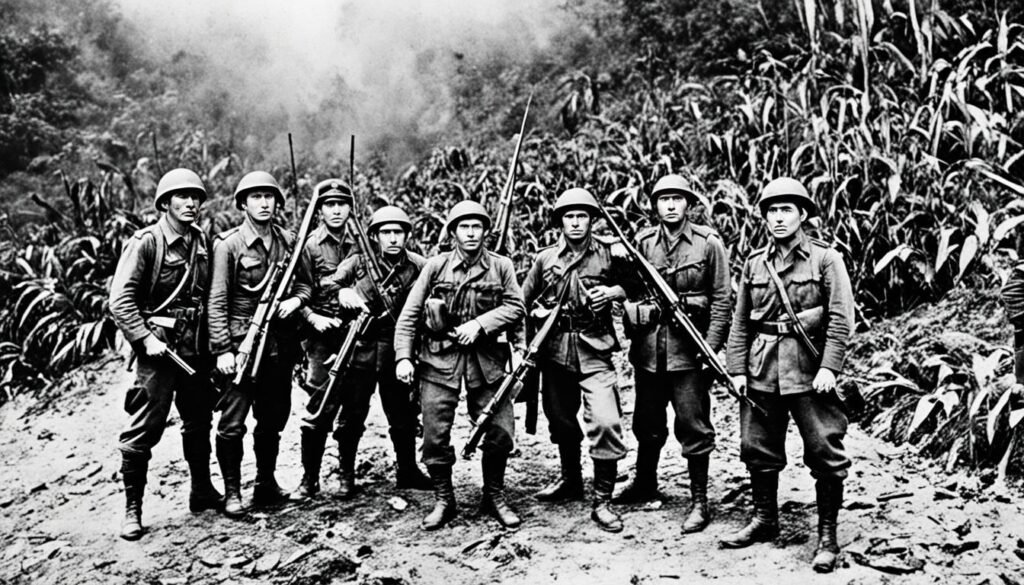
Psychological Warfare and Propaganda
Welcome to Section 8 where we discuss the Filipino Guerrillas in World War II. Here, we focus on the essential part psychological warfare and propaganda played in the Filipino guerrilla movement.
Demoralizing the Enemy
The Filipino guerrillas knew how to demoralize the enemy. They used various methods to weaken the Japanese forces’ spirits. This included spreading false information to make the Japanese troops doubt their leaders.
They spread rumors to create an atmosphere of confusion and doubt. This made the Japanese soldiers question their own loyalty to their leaders. The guerrillas aimed to weaken the enemy’s firmness and disrupt their activities.
“We used whispers and rumors like a weapon, infiltrating their ranks with false information, casting doubt on their leaders, and ultimately causing the enemy to question everything they thought they knew,” said guerrilla leader Juan Dela Cruz.
The guerrillas also used psychological means like pamphlets and graffiti. These materials aimed to lower the Japanese soldiers’ morale and raise support for the Filipino resistance.
Strengthening Guerrilla Morale
Psychological warfare was also key to boosting the guerrillas’ own morale. They shared stories of bravery and sacrifice, inspiring their fighters. These tales reminded them of their cause’s righteousness, filling them with pride and determination.
Moreover, they arranged cultural events, such as plays and concerts. These events provided much-needed breaks and lifted the spirits of the guerrillas. It helped reinforce their commitment to the resistance.
In the following section, we’ll cover how the Filipino guerrillas became the resistance’s spine. We’ll look at how they organized and their key role in liberating the Philippines.
Filipino Guerrillas: The Backbone of Resistance
During World War II, the Filipino guerrillas were key in fighting back against the Japanese. They showed courage and creativity. This helped the Philippines eventually become free again.
Organization of Guerrilla Forces
Filipino guerrillas were part of many groups, like the Hukbalahap. Each group had leaders and specific aims. They worked together to fight against the Japanese successfully.
They used secret ways to talk and share information. This helped them plan attacks. Because of how they were organized, the Japanese struggled to stop them.
The Role of Guerrilla Activity in the Liberation of Philippines
The guerrillas’ actions were crucial in freeing the Philippines. They attacked Japanese soldiers in smart ways. They also broke the enemy’s supply lines, causing them big problems.
They gave the allies important information. This helped the allies win battles. Knowing the land well, and with the people’s support, they shifted the war’s balance.
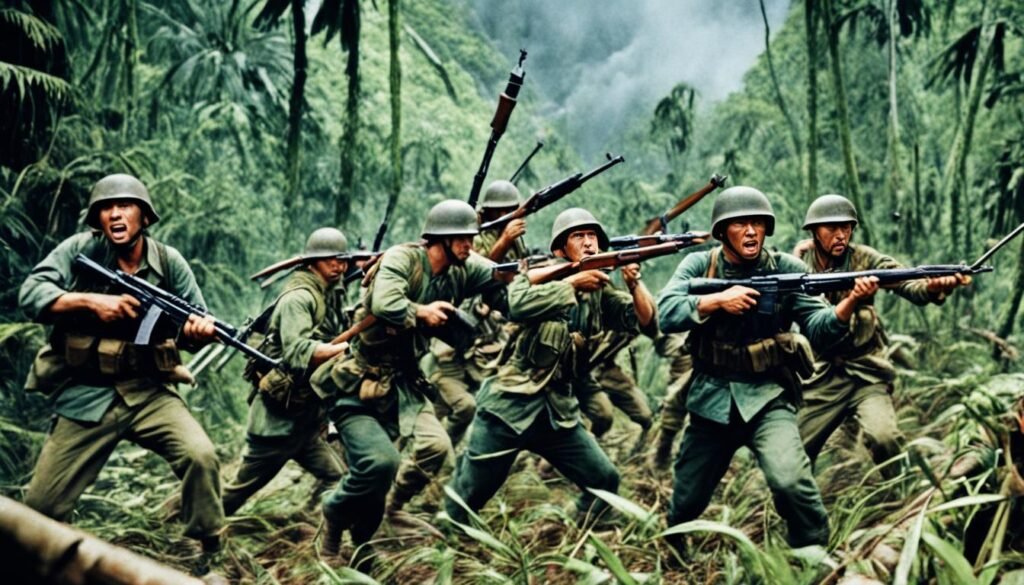
Despite the great danger, the Filipino guerrillas stayed strong. They brought hope to their people. Their fight for freedom and the hardships they faced will never be forgotten in the Philippines.
For more information on the Filipino guerrilla movement during World War II, visit https://www.britannica.com/event/Hukbalahap-Rebellion.
Reigniting Hope: The Role of Women in Guerrilla Movements
Women have been key in guerrilla movements throughout history. In World War II, Filipina women led the charge. They reignited hope and challenged norms by joining the fight for their land.
These women fought against several odds. They showed determination and resilience by supporting the men in various roles. They worked as couriers, medics, and fighters, breaking stereotypes.
“Women can also fight for freedom, facing different odds. Our unwavering spirit can spark hope in our people.”
They were truly dedicated, risking life for crucial missions. They not only gathered vital info and supplied the troops but also pushed the limits of what society thought women could do. Their unyielding sense of purpose moved them ahead.
Women changed the game in guerrilla movements. They weren’t just behind the scenes; they were in the thick of battle. This shook up the traditional view of women and ignited a fire in Filipinas to fight for their standing.
Empowering Future Generations
Their actions laid the groundwork for real gender equality in the Philippines. By securing their country’s freedom, they showed the world what women are capable of. This redefined societal perceptions and inspired future activism.
These impacts are still felt today. Filipino women are leaders in many fields. They’re leading the charge for change, making their society more equal and open. They continue reigniting hope, looking for a better future for all.
We salute these brave women from the WWII guerrilla movements. Their work and legacy inspire many. They show the power of women in making a difference for ages to come.
| Women’s Roles in Guerrilla Movements | Examples |
|---|---|
| Couriers and Messengers | Anna Santos, Maria Reyes |
| Medics and Nurses | Dr. Carmen Hernandez, Sister Maria Lopez |
| Intelligence Gathering | Luisa Gomez, Sofia Morales |
| Combatants | Amelia Telan, Juana Rodriguez |
Diverse Tactics and The Element of Surprise
During World War II, the Filipino guerrillas used many different tactics against the Japanese. One tactic, the element of surprise, helped them a lot. It let them catch the Japanese off guard and gain big advantages.
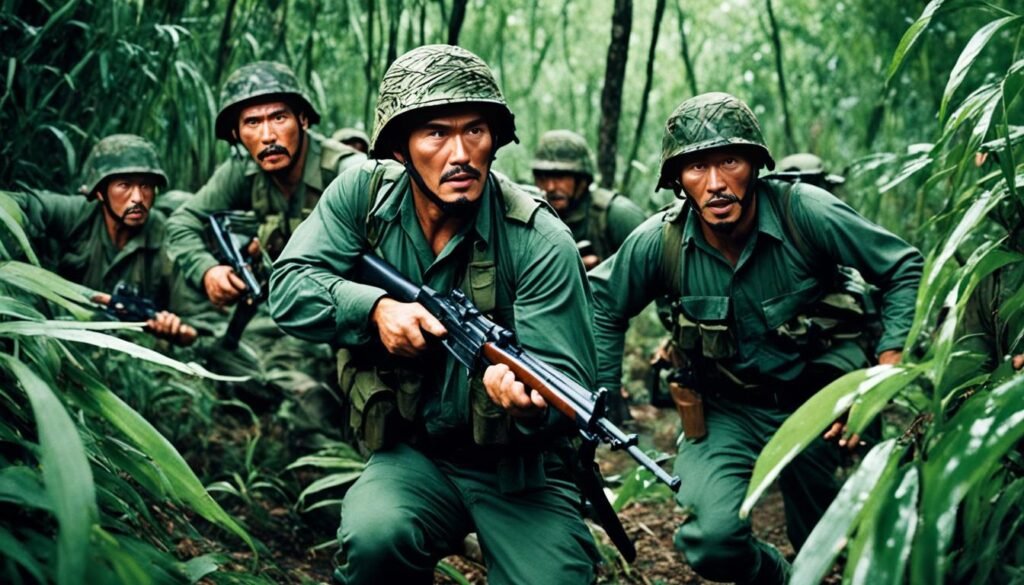
Sabotage and Raid Operations
The guerrillas often carried out sabotage and raids. These involved secretly attacking Japanese bases and cutting their supply lines. This action hurt the Japanese ability to fight.
They planned carefully, using their knowledge and help from locals. By attacking important places like bridges and enemy headquarters, they caused chaos in the Japanese ranks.
One major success was the raid on Cabanatuan, a POW camp. With American help, the guerrillas freed over 500 prisoners.
To plan their attacks, the guerrillas had many spies. These spies gave them information about the Japanese, which was crucial for choosing the best targets.
Strategic Alliances with Allied Forces
The Filipino guerrillas knew joining forces with the Allies was key. This gave them access to more resources and military support.
General Douglas MacArthur’s promise to come back gave the guerrillas hope. When he started to retake the Philippines, the guerrillas helped by giving him vital information and support.
The guerrillas also teamed up with other Allied military groups. A big help came from the United States Army and the Australians. This support made the guerrillas stronger and helped them win their missions.
By using many tactics and working with the Allies, the Filipino guerrillas fought the Japanese well. They were resourceful and determined. Their efforts were important in freeing the Philippines.
For more details on the guerrilla actions, you can read a report by General Douglas MacArthur.
Life Under Occupation and the Repercussions of Revolt
The Japanese occupation of the Philippines was a hard time. Life changed a lot when Japan took over. People had to follow many rules. Anyone who fought against Japan faced tough punishments.
Civilian Life Adjustment and Support
Filipinos had to adapt greatly during the occupation. They lost many freedoms and rights. New rules and restrictions changed everyone’s daily life. Getting basic needs was hard. Yet, Filipinos found ways to help each other and the fighters.
Many Filipinos helped the guerrilla fighters despite the dangers. They carried messages and gave food and a place to stay to the fighters. This help was crucial for the fighters and kept the hope for freedom alive.
Risks of Retribution and the Cost of Defiance
People who went against Japan often suffered badly. Japan punished them severely. Anyone thought to help the fighters could be tortured or killed.
Going against Japan came at a great cost. Houses were searched, and property taken. Families and friends were questioned and treated badly. Japan punished not just the individual, but also their loved ones.
With such high risks, Filipinos felt a lot of stress. They faced danger every day. But their courage and community spirit were key in winning back their country.
Intelligence Gathering and Counter-Intelligence Success
The Filipino guerrilla movement in World War II depended greatly on smart spying and defense against Japanese control. This part shows how key intelligence work was for the Filipino group’s victories.
Gathering information was crucial. The guerrillas learned about the Japanese by finding out about their troops, where they got their supplies, and what places they focused on. Armed with this info, they could launch attacks better and sneak away without getting caught.
They had a group of brave people working for them, risking their lives to learn about the enemy. These spies were among the Japanese, talking to locals and keeping an eye on what Japan was up to. They used disguises, codes, and secret meetings. This helped them pass on important facts to their own fighters.
But it wasn’t just about finding out what the enemy was doing. The Filipinos also worked hard to keep their own secrets safe from the Japanese. They kept changing how they operated, to stay hidden and avoid getting caught.
Another smart move they made was to trick the enemy using deception. They spread lies, set up fake missions, and even tricked the Japanese with their own agents. This way, they kept the upper hand, always surprising the Japanese with their next move.
“Intelligence is the key to victory. It allows us to anticipate the enemy’s moves, exploit their weaknesses, and gain the upper hand in our fight for liberation.” – General Aguinaldo, Filipino Guerrilla Leader
The guerrillas’ work in gathering and protecting their intel was vital. It helped them fight back against Japan, making it hard for the enemy to move freely. Thanks to their smart work, they made a big difference in freeing the Philippines in the end.
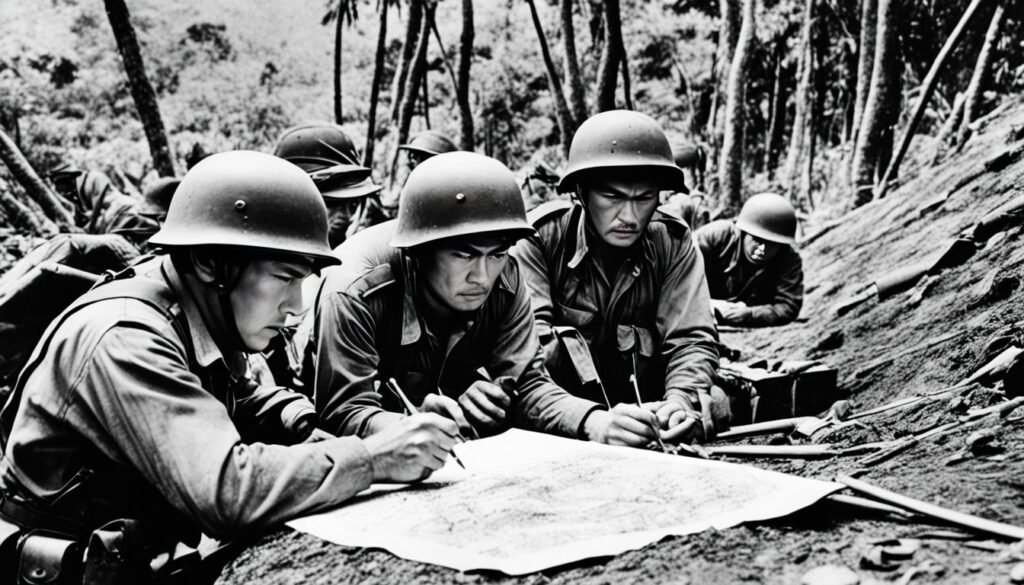
Recognized Guerrilla Units Post-War: Their Legacy and Compensation Struggles
After World War II, Filipino guerrilla units had to fight for something new. This was recognition and payment for their bravery. They had helped fight against the Japanese during the war. And now, they wanted credit and thanks for their sacrifices to free the Philippines.
Transition to Official Armed Forces
After the war, many guerrilla units merged into the Philippines’ official armed forces. This step let them keep serving their country. It also gave them some recognition for fighting in the war.
US Recognition and Veteran Benefits Dispute
Despite their big help, many units found getting U.S. recognition hard. Being recognized by the U.S. was key for getting veteran benefits. It was a long and tough process for these soldiers.
The dispute over veteran benefits focused on how these guerrilla units were seen. The process to decide this was complex. Different rules and categories made things harder. This meant the Filipino fighters had to keep trying to get what they rightfully deserved.
| Challenges Faced | Legacy |
|---|---|
| Tirelessly advocating for recognition | Inspiring future generations |
| Battling bureaucratic obstacles | Preserving the memory of their sacrifices |
| Seeking fair compensation | Ensuring their place in history |
Their legacy is marked by their strong will and never giving up. Even today, their battle for respect and payment shows how brave and loyal they were. This ongoing fight keeps their memory alive. The world will always remember and respect their contributions during the war
Conclusion
The brave actions of the Filipino guerrillas were crucial in freeing the Philippines during World War II. They fought back against the Japanese with unwavering courage and a strong love for their country. Their use of ambushes and hit-and-run tactics threw the Japanese off balance, preventing total control.
The guerrillas’ success came from their deep knowledge of the land and by forming wide-reaching spy networks. They managed to gather key details about the Japanese and use them to strategize. This allowed them to surprise the enemy and make a huge impact, turning the tide of battle in their favor.
The Filipino people were united in their support for these guerrilla fighters. They offered supplies, safe places to hide, and crucial information. This support showed the deep unity in the Philippines’ effort to achieve freedom.
After the war, the guerrillas faced new challenges, like fighting for recognition and compensation. Their struggle with the United States for acknowledgement continues today. Yet, their bravery and honor remain an inspiring part of the Philippines’ history, teaching future generations to protect their home in tough times.
To delve deeper into the Filipino resistance’s history, strategies, and current challenges, check out this comprehensive article.
FAQ
What were the tactics used by Filipino Guerrillas during World War II against the Japanese?
The Filipino Guerrillas used many tactics in their fight. These included setting ambushes, blowing up important targets, quick attacks, and gathering information. They knew the land well and worked with other armies to win.
What was the impact of General MacArthur’s strategic retreat on the Filipino guerrillas?
General MacArthur leaving the Philippines affected the guerrillas greatly. His “I shall return” gave them hope, though they had to fend for themselves against Japan. His retreat marked a tough but rallying moment for their war effort.
How did the Filipino guerrillas disrupt Japanese operations and achieve success in their resistance efforts?
The guerrillas used ambushes, sabotage, and quick attacks to hinder Japan’s moves. Locals supported them with information, supplies, and hiding spots. Without this teamwork and their courageous actions, they wouldn’t have stood a chance against the Japanese soldiers.
What role did women play in the Filipino guerrilla movements during World War II?
Women were key in the guerrilla actions. They fought just as hard as the men, providing valuable help in the war. They showed bravery and resolve in pushing back the Japanese, making great sacrifices for their country.
How were intelligence gathering and counter-intelligence successful in the Filipino guerrilla movement?
Knowing about Japanese moves was essential. It helped the guerrillas plan better. They also worked to stop the Japanese from finding and stopping them. Their intelligence work was critical in their struggle against Japan.
What recognition and compensation struggles did the Filipino guerrilla units face after the war?
After the war, many guerrillas found it hard to get the recognition and support they deserved. Various units struggled to be seen as official forces, wanting the benefits that came with it. This fight for acknowledgment is a long-standing issue.
Source Links
- https://opensiuc.lib.siu.edu/cgi/viewcontent.cgi?article=1044&context=legacy
- https://en.wikipedia.org/wiki/Philippine_resistance_against_Japan
- https://history.army.mil/books/wwii/macarthur reports/macarthur v1/ch10.htm

